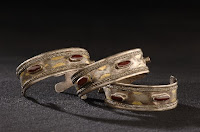Pre-Sikh History of the Kara Symbol Beyond Sikhism.
Introduction:
The origins of the Kara, a significant religious symbol in Sikhism, trace back to a history pre-dating the emergence of Sikhism itself. Unveiling the roots of the Kara sheds light on its evolution, purpose, and cultural significance.
Ancient Roots of the Kara:
Dating back to ancient times, the Kara's history predates the advent of Sikhism. Initially, it served as an emblematic ornament among various South Asian communities, symbolizing strength, unity, and resilience. Its roots can be traced to diverse cultural practices and spiritual ideologies that flourished in the region.
The Kara in Hindu and Buddhist Traditions:
Before the rise of Sikhism, the Kara found a place in Hindu and Buddhist traditions. In Hinduism, it often symbolized the cyclical nature of life, while in Buddhism, it was embraced as a token of enlightenment. The Kara, during this period, transcended religious boundaries, becoming a shared symbol among diverse communities.
Central Asian Cultures:
As trade routes flourished, the Kara underwent transformations influenced by Persian and Central Asian cultures. The symbol became a reflection of the amalgamation of diverse cultural influences, signifying not only religious affiliations but also regional trade and connectivity.
The Kara's Evolution During Sikhism's Emergence:
With the emergence of Sikhism in the 15th century, the Sikh Kara took on a new significance. Guru Nanak, the founder of Sikhism, embraced the Kara as a distinctive identity for Sikhs. The circular shape of the Kara symbolized the eternal nature of God, while its unbroken form represented the unbreakable bond between the Sikh and the divine.
Cultural Unification through the Kara:
The Sikh Kara played a pivotal role in fostering a sense of unity among Sikhs during turbulent times. As the community faced external threats and persecution, the Kara became a unifying symbol, strengthening the resolve of Sikhs and reinforcing their commitment to their faith.
Over the centuries, the Kara has retained its significance within Sikhism. It is now an integral part of a Sikh's identity, serving as a constant reminder of the teachings of the Gurus. Its circular shape continues to represent the timeless nature of the divine, fostering a sense of spiritual connection among Sikhs worldwide.
Conclusion:
In conclusion, the history of the Kara extends far beyond the confines of Sikhism, originating in ancient traditions that embraced its symbolism for diverse purposes. From Hindu and Buddhist practices to the influences of Persian and Central Asian cultures, the Kara has evolved, transcending religious boundaries and becoming a unifying emblem. In the context of Sikhism, it has become an enduring symbol, embodying the community's strength, resilience, and unwavering connection to the divine. Today, the Kara stands as a testament to the rich cultural tapestry of South Asia and the ability of symbols to transcend time, space, and religious boundaries. Embracing the active voice, this exploration into the history of the Kara not only unravels its past but also underscores its enduring relevance in the present.





Comments
Post a Comment